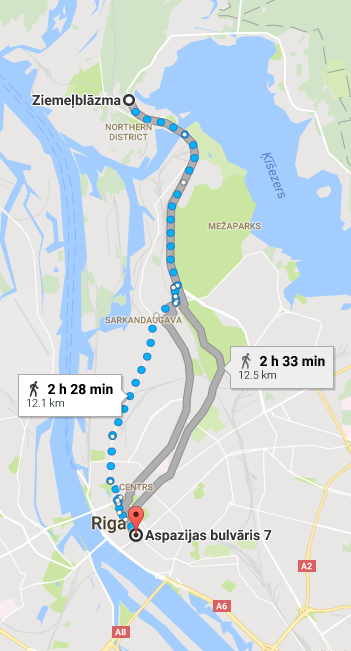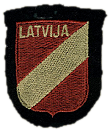14
[1The witness did not] 2actually see Hazners at any of these places, but knew he was there because they conversed over the telephone. 20/
 Google Maps and the INS's location for Ziemeļblāzma match.1 The INS's coordinates (degrees + minutes) are accurate to within one kilometer at Rīga's latitude. Shown are walking time estimates to the Prefecture. Even in modern Rīga this is a twenty-plus minute drive with no traffic, and certainly not within convenient walking distance as the INS contends. Hāzners had no relation with the Prefecture. Nor did he take captured Russians there as the INS baselessly speculates.
Google Maps and the INS's location for Ziemeļblāzma match.1 The INS's coordinates (degrees + minutes) are accurate to within one kilometer at Rīga's latitude. Shown are walking time estimates to the Prefecture. Even in modern Rīga this is a twenty-plus minute drive with no traffic, and certainly not within convenient walking distance as the INS contends. Hāzners had no relation with the Prefecture. Nor did he take captured Russians there as the INS baselessly speculates.When asked on cross-examination where Bolderaja is in relation to Riga, 3Vilips testified that they are approximately 100 kilometers (66 miles) apart. In fact, a map of Latvia shows that they are separated by no more than ten miles, and Mangalsala is closer to Riga than Bolderaja. 20a/ Ziemelblazma does not appear on the map, but its geographic coordinates are 57'02"N, 24'07"E, which is within 4walking distance of downtown Riga, and perhaps 15 minutes by car from the Prefecture. 21/ 5If Hazners did capture any Russians during this period, the Prefecture was probably the closest place they could have been detained.
Hazners' story raises other questions. For example, his own account, corroborated by an article in Tevija, 22/ indicates that he spent the five days before July 1 under very harsh circumstances in Riga's Central Prison, with nothing to eat but foul smelling soup and moldy porridge. Nevertheless, 6he claimed to have had the strength to pursue Russians for five consecutive days thereafter. Then, this professional soldier, a product of the Latvian Military Academy and the Staff School, supposedly went home to bed without
| 20/ | Cf., 7Meiers deposition, p.21, where it was stated that the Russians had cut off telephone service before their retreat. Service was still being restored in the center of Riga during the first week in July 1941. |
| 20a/ | A reproduction of a map of Latvia is included as Appendix A. |
| 21/ | U.S. Army Topographic Command, Geographic Names Division National Intelligence Survey Gazetteer of Official Standard Names, USSR. Vol. 7 (July, 1970). |
| 22/ | Ex. R-38 |
Examination
[pg. 13]1“The witness did not” [pg. 14]2“actually see Hazners at any of these places, but knew he was there because they conversed over the telephone. 20/” . . . [footnote] 7“Meiers deposition, p.21, where it was stated that the Russians had cut off telephone service before their retreat. Service was still being restored in the center of Riga during the first week in July 1941.”
In his memoir2, Hāzners recounts his surprise that the phone was still operating, that they were able to communicate between areas where Russians were leaving and Germans were entering. As neither Bolderāja or Mangaļsala are "central Rīga," there is no basis to contend Meiers' deposition and Vilips' testimony regarding phone contact are incompatible.
Further investigation reveals the INS's contentions that Meiers' testimony indicates Hāzners could not have talked by telephone either with Vilips in Bolderāja or with Veiss in Rīga misrepresent the record, because Meiers also stated in his deposition (page 143) that he himself had communicated with the suburbs from central Rīga, that communication was not cut.
Vilips is certainly mistaken on distance, but this is understandable if he estimated distance based on travel time. In today's Rīga, with no traffic, Bolderāja is a half hour drive to the Prefecture, longer to Annas Street where Veiss' headquarters was located. Bolderāja was also on the side of the river fully occupied by the Germans. This would have taken well over an hour to drive, contending with German forces and checkpoints—certainly feeling like 100 kilometers to someone now living in America in the 1970's attempting to think back to events nearly 40 years earlier. The INS implies an attempt at deception to place Hāzners as far away as possible.
In today's Rīga, with no traffic, Ziemeļblāzma is a twenty-plus minute drive to the Prefecture (Aspazijas bulv. 7), and a two and a half hour walk. We can't begin to imagine how much longer it would have taken in a war-torn Rīga just after the German invasion: swarming with troops, heavy transports, artillery, tanks, and dotted with military check-points. The INS insists that Hāzners would have had no problem getting away ("perhaps 15 minutes by car from the Prefecture," "within walking distance of downtown Riga") for a Jew-beating quickie in town.
Per Hāzners's memoir, Russian prisoners were taken to the nearby harbor port to be turned over to German authorities. This sort of baseless conjecture typifies the INS's cynical opportunism, filling gaps in their facts with Hāzners–Nazist speculation.
Per Hāzners's memoir, the Red Army were attempting to escape west to east across the Daugava river in small boats, that is, from Vilips' aforementioned position in Bolderāja towards Hāzners's position in Mangaļsala. Hāzners and the other Latvians simply waited until the Russians got close to the river bank, then surprised them, shouting "Hands up!", had them toss their weapons into the river, and arrested them. Hāzners felt sorry for them, most were still teenagers—and he was thankful that not a single life was lost on either side. There was no physically torturous pursuit which the INS contends Hāzners would have been too weak to endure.
Yet the INS sees no conflict in turning around and contending that in the very same gravely debilitated condition, Hāzners hounded and pursued Jews throughout Rīga, beat Jews so energetically and violently their teeth later fell out, and herded Jews down streets and into a synagogue to burn them alive.
| 1 | We use the current Ziemeļblāzma bus stop as point of origin. |
| 2 | Varmācības Torņi ("Towers of Tyranny"). 1977. Vaidava. |
| 3 | Testimony of Janis Meiers, 1-November-1978, deposition. |
